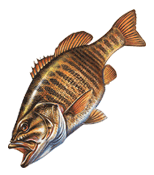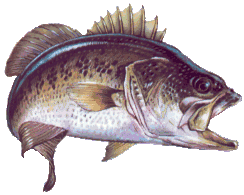|

The Float & Fly Technique
By- Mac Lassiter
Most all of us started our fishing at a young age watching a bobber, waiting patiently on that bluegill or catfish to
take a bite. The excitement of watching a bobber or float is still deep in many of our hearts, and is a main component in
one of the most innovated techniques for catching all species of bass, especially monster Smallmouth, in the dead of winter.
It's called the Float and Fly, so don't put up your rods, and winterize that boat just yet this technique will extend your
bass fishing season for months.
The Float & Fly technique was developed in the hills of eastern Tennessee by Charlie Nuckols as a system to fool cold,
sluggish, suspended bass in the clear, cold, winter waters of Tennessee. Nuckols the owner of Bullet Lures, developed this
method after finding suspended fish on his graph in his local waters, and was not able to catch them on his old stand-by,
the jigging spoon, And knew once the water temperature dropped into the low 40's, that the spoon would not even provoke a
bite.
The Float & Fly system has improved a great deal since its development. Local guides and Smallmouth experts Stephen
Headrick (owner of Punisher jigs), Bob Coan, John Davis, and Jim Duckworth have worked on the system, and developed different
techniques, and tackle that is unique to each angler, but the system still falls on the backbone of a small hair jig and float.
The Float & Fly technique is at its best when water temperatures drop into the mid to low 40's and when most anglers
have called it a year, and the system only gets better as winter set it's cold grip upon us. Some of my best days using the
Float & Fly have been on a North wind at 15 to 20 mph, with sleet and snow pounding me in the face. Sound like duck hunting
weather to you? Also this technique works best in clear water, but will also work effectively in slightly stained water conditions.
Most anglers know a major technique for lethargic bass is to down size baits and a slow presentation. And this is what
makes this system so effective.
The components:
Let's take a look at the components that make up the system
1. The fly, or jig, is a tiny lead head tied with craft hair or marabou and are usually most effective in the 1/32 or
1/16 ounce size.
2. The float or strike indicator as most diehard Float & Fly anglers call it, is a small plastic or Styrofoam float
¾ to 1-inch in size, most anglers shy away from the slip float because the fly is so small and light, the line will not flow
through the float. The float bobs on the surface and keeps the fly suspended at the desired depth, dangling in front of the
fish.
3. The rod is a long 9 foot to 10 foot flexible spinning rod, this size rod is needed to cast the long leader, and to
absorb the violent, and strong surges, and runs of the fish while using extremely light line.
4. Line is used in light weight, small diameter, usually no larger than 8 pound test, and I have had the best results
using 6 pound fluorocarbon, this light line and small diameter is needed because of the ultra clear water that is needed to
make this technique effective.
Where to fish:
The Float & Fly method will work in any lake where Smallmouth suspend in winter, and when you have clear to moderately
stained water conditions.
Some of the high percentage places I look for are Bluff banks, Sloping rock banks, Rocky points, and Deep coves. Also
look for logs or tree tops hanging off the bank into deep water, these are a great location for big Spotted bass.
Executing the technique:
This technique is so simple, the first thing I suggest is to idle around in a likely area, and locate fish with your graph.
The easiest fish to catch, from my experience will be suspended in 8 to 15 feet, and if baitfish are present above them, that's
even better.
Once the depth has been determined, strip off a sufficient amount of line off the reel, and position the float so the
fly will be presented at the bass's depth, or slightly above them.
Next, comes what some believe is the only hard part to this entire technique. With a large amount of line out between
your float to your fly, sometimes up to 20 feet, the cast is sometimes difficult to master, but with practice, it will come
second nature.
The cast is executed much like the cast of a fly fisherman, leave about 1 to 2 feet of line between your rod tip and float,
and with a sweeping motion bring the rod back until you hear the fly hit the water behind you, then with a forward sweeping
motion make your cast, It might sound difficult, but with a little practice you will have it down in no time.
Cast to your target, and let the fly settle to the end of the line, and with short twitches of the rod tip, make the float
dance and bob, this will put action to your fly, making the craft hair pulsate. If there is a slight chop on the water, just
let it sit there and let the wave action work the float for you.
Watch the float carefully for a strike, a lot of times the float will tip to one side, or just spin around, if you see
this, lean back with a sweeping motion to set the hook, always be careful not to snap the rod or make a hard hook set, you
will snap the light line very easily.
As with any technique this method works better at some times than others, on overcast, cloudy days, Smallmouth will suspend
shallower, and are a lot easier to catch. The bite usually gets tougher when there is a lot of sun, and the fish will suspend
much deeper, making it hard to reach them with this method. I have had my best luck on sunny days fishing shaded banks, or
wind blown banks, and can usually pick up a few fish.
So don't put that boat up yet, go out and give this technique a try, you might just catch the biggest Smallmouth of your
life.
Article by: Mac Lassiter
Pro-staff: Reeltimeanglers.com and Delaware Tackle
Sponsors: Secret Weapon lures, Esox Rods, Fish Hedz,Driftwood Lures, Big Daddy's Market
|

